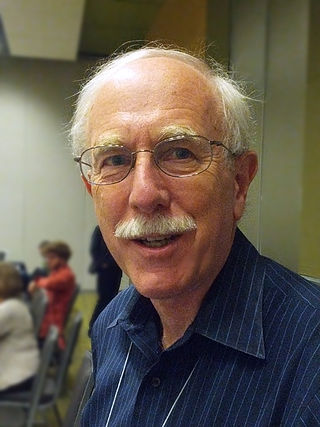
James H. McClellan is the Byers Professor of Signal Processing at the Georgia Institute of Technology. He is widely known for his creation of the McClellan transform and for his co-authorship of the Parks–McClellan filter design algorithm.
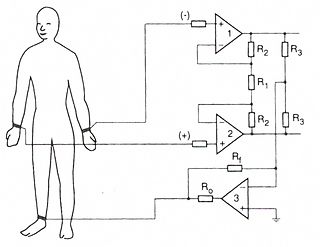
A Driven Right Leg circuit or DRL circuit, also known as Right Leg Driving technique, is an electric circuit that is often added to biological signal amplifiers to reduce common-mode interference. Biological signal amplifiers such as ECG (electrocardiogram) EEG (electroencephalogram) or EMG circuits measure very small electrical signals emitted by the body, often as small as several micro-volts. However, the patient's body can also act as an antenna which picks up electromagnetic interference, especially 50/60 Hz noise from electrical power lines. This interference can obscure the biological signals, making them very hard to measure. Right leg driver circuitry is used to eliminate interference noise by actively cancelling the interference.
Ernst Adolph Guillemin was an American electrical engineer and computer scientist at the Massachusetts Institute of Technology who spent his career extending the art and science of linear network analysis and synthesis. His nephew Victor Guillemin is a math professor at MIT, his nephew Robert Charles Guillemin was a sidewalk artist, his great-niece Karen Guillemin is a biology professor at the University of Oregon, and his granddaughter Mary Elizabeth Meyerand is a Medical Physics Professor at the University of Wisconsin-Madison.
Leslie Alexander Geddes was an electrical engineer and physiologist. He conducted research in electromyography, cardiac output, cardiac pacing, ventricular defibrillation, and blood pressure. He discovered and demonstrated precisely the optimal sites on the chest for defibrillation or pacing.
Herman P. Schwan was a biomedical engineer and biophysicist, recognized as the "founding father of biomedical engineering." He was born in Aachen, Germany, and died in his home Radnor, Pennsylvania.
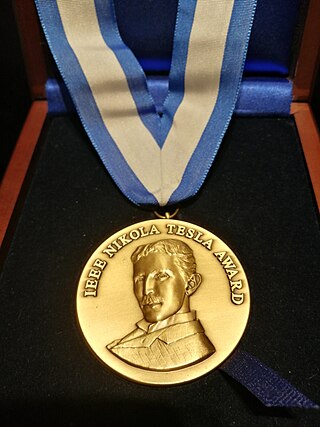
The IEEE Nikola Tesla Award is a Technical Field Award given annually to an individual or team that has made an outstanding contribution to the generation or utilization of electric power. It is awarded by the Board of Directors of the IEEE. The award is named in honor of Nikola Tesla. This award may be presented to an individual or a team.
Arun Phadke is a University Distinguished Research Professor in the Department of Electrical and Computer Engineering at Virginia Tech. Along with fellow Virginia Tech professor James Thorp, Dr. Phadke received The Franklin Institute's 2008 Benjamin Franklin Medal in Electrical Engineering for their contributions to the power industry, particularly microprocessor controllers and Phasor measurement unit (PMU) technology in electric power systems.
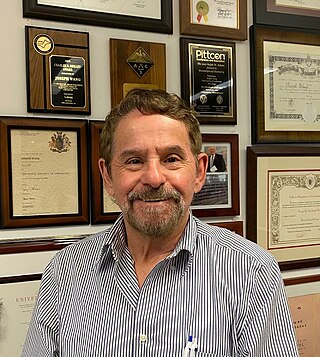
Joseph Wang is an American biomedical engineer and inventor. He is a Distinguished Professor, SAIC Endowed Chair, and former Chair of the Department of Nanoengineering at the University of California, San Diego, who specialised in nanomachines, biosensors, nano-bioelectronics, wearable devices, and electrochemistry. He is also the Director of the UCSD Center of Wearable Sensors and co-director of the UCSD Center of Mobile Health Systems and Applications (CMSA).
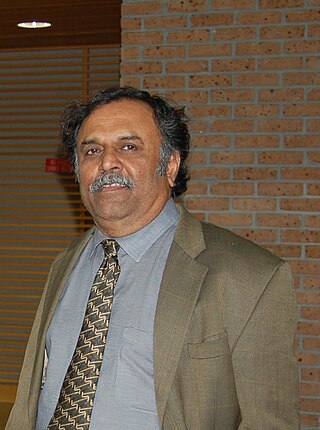
Sundaraja Sitharama Iyengar is an Indian-born American computer scientist and the Distinguished University Professor, Ryder Professor and Director of Computer Science at Florida International University, Miami, Florida, USA. He also founded and directs the Robotics Research Laboratory at Louisiana State University (LSU). He has been a visiting professor or scientist at Oak Ridge National Laboratory, Jet Propulsion Laboratory, Naval Research Laboratory, and has been awarded the Satish Dhawan Visiting Chaired Professorship at the Indian Institute of Science, the Homi Bhaba Visiting Chaired Professor (IGCAR), and a professorship at the University of Paris (Sorbonne).
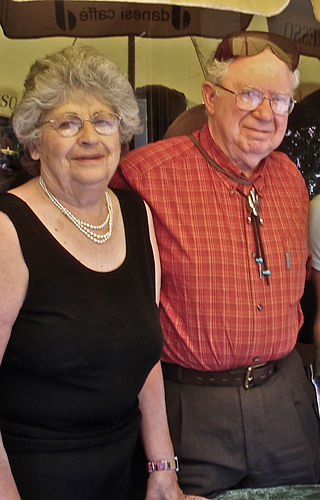
Thelma Estrin was an American computer scientist and engineer who did pioneering work in the fields of expert systems and biomedical engineering. Estrin was one of the first to apply computer technology to healthcare and medical research. In 1954, Estrin helped to design the Weizmann Automatic Computer, or WEIZAC, the first computer in Israel and the Middle East, a moment marked as an IEEE Milestone in Electrical and Computer Engineering. She was professor emerita in the Department of Computer Science, University of California at Los Angeles (UCLA).
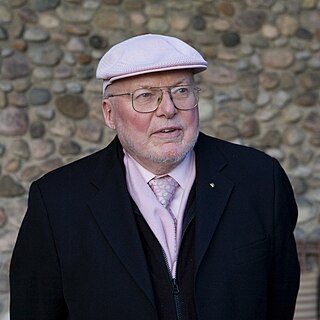
Kenneth Carless Smith was a Canadian electrical engineer and academic. He was a Professor Emeritus, University of Toronto, cross-appointed to the departments of electrical and computer engineering, mechanical and industrial engineering, computer science, and the faculty of information science. Smith died on October 29, 2023, at the age of 91.
Benjamin Seaver Blanchard, Jr. was an American systems engineer and Emeritus Professor of Industrial and Systems Engineering at Virginia Tech, who was awarded the INCOSE Pioneer Award jointly with Wolt Fabrycky as "practitioner, teacher, and advocate of Systems Engineering."
Mohamed (Mo) El-Aref El-Hawary, was an Egyptian-born Canadian scientist of electric power system studies and the involvement of traditional/modern optimization algorithms, fuzzy systems, and artificial neural networks in their applications. El-Hawary was a mathematician, electrical engineer, computational intelligence researcher and professor of electrical and computer engineering at Dalhousie University.
Olga Boric-Lubecke is a Professor of electrical engineering at the University of Hawaiʻi at Mānoa. She was named Fellow of the Institute of Electrical and Electronics Engineers (IEEE) in 2015 for "contributions to biomedical microwave technology". She co-founded Adnoviv a startup working with sensor technology founded in 2013 with her colleague Victor Lubecke.

Reza Ghodssi is a Professor in the Department of Electrical and Computer Engineering and the Institute for Systems Research (ISR) at the University of Maryland, College Park, where he directs the MEMS Sensors and Actuators Lab and holds the Herbert Rabin Distinguished Chair in Engineering. Ghodssi is also the Inaugural Executive Director of Research and Innovation for the A. James Clark School of Engineering at the University System of Maryland at Southern Maryland (USMSM). He is best known for his work designing micro- and nano-devices for healthcare applications, particularly for systems requiring small-scale energy conversion and biological and chemical sensing.
Deborah J. Jackson is an American physicist and Program Manager at the National Science Foundation, and a Fellow of the National Society of Black Physicists. She was the first African American woman to receive a Ph.D. in physics from Stanford University. She is an expert on "electromagnetic phenomena" with a research and development career that spans the full range of the electromagnetic spectrum from materials studies using hard x-ray wavelengths, to nonlinear optics and spectroscopy in the near-infrared, to the fielding of radio frequency instrumentation on deep space missions such as Cassini and Mars Observer.

Jürgen W. Czarske is a German electrical engineer and a measurement system technician. He is the director of the TU Dresden Biomedical Computational Laser Systems competence center and a co-opted professor of physics.

Mohamad Sawan is a Canadian-Lebanese electrical engineer, academic and researcher. He is a Chair Professor at Westlake University, China, and an Emeritus Professor of Electrical Engineering at Polytechnique Montréal, Canada.
Todd Prentice Coleman is an American electrical engineer and associate professor at Stanford University. He is a Fellow of the American Institute for Medical and Biological Engineering and Institute of Electrical and Electronics Engineers.
Changzhi Li is a full professor and Whitacre Endowed Chair in Electrical & Computer Engineering, at Texas Tech University. He is also head of Biomedical Integrated Devices and Systems (BIDS). His research focuses on RF/Analog Circuits and Microwave/Millimeter-Wave sensing for Healthcare, Security, and Human-Machine Interface. His contributions have led to his elevation as a Fellow of the National Academy of Inventors (NAI) and he was named as an IEEE Microwave Theory and Techniques Society (MTT-S) Distinguished Microwave Lecturer (DML), Tatsuo Itoh class of 2022–2024. In 2024 he was elevated to IEEE Fellow









